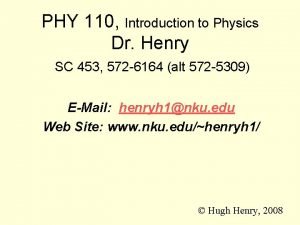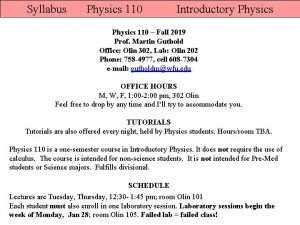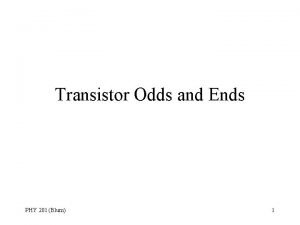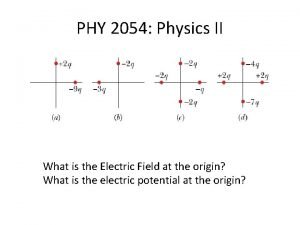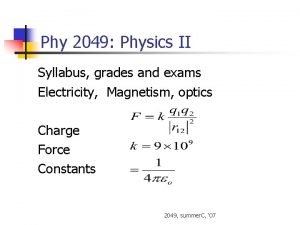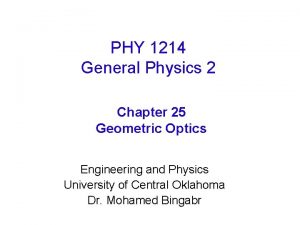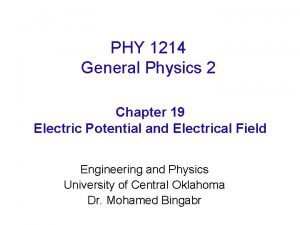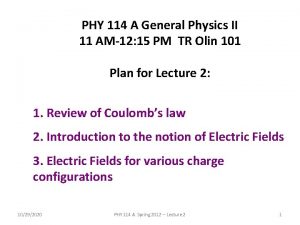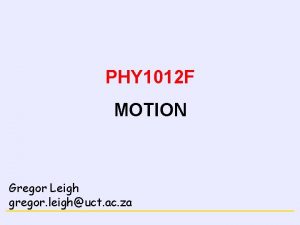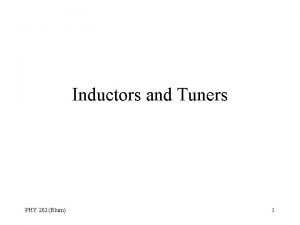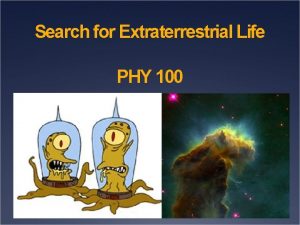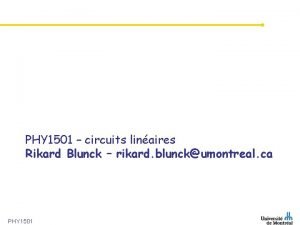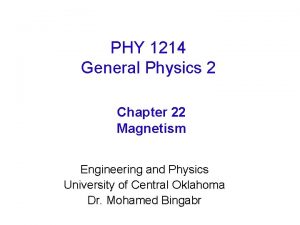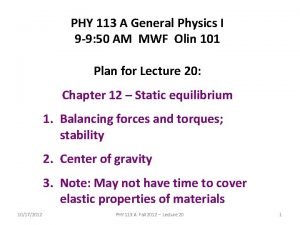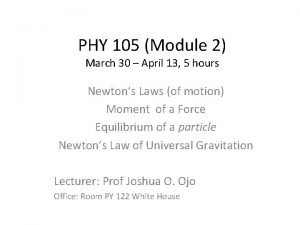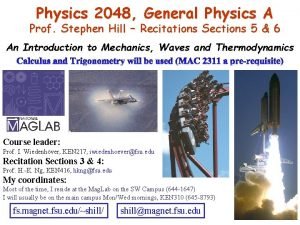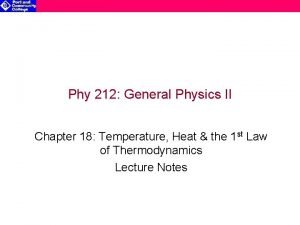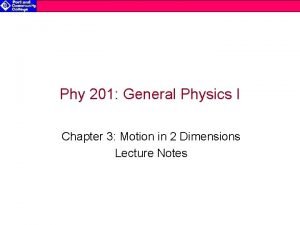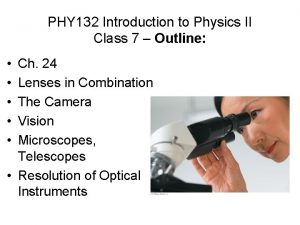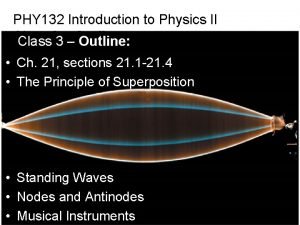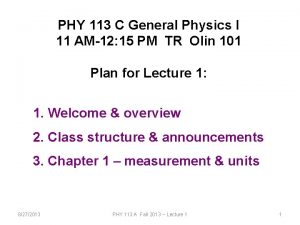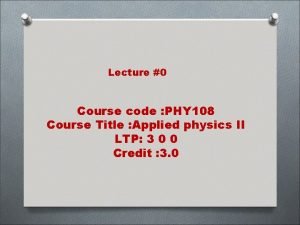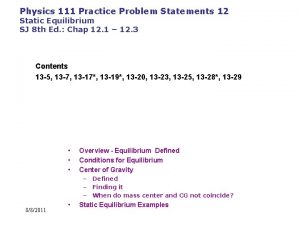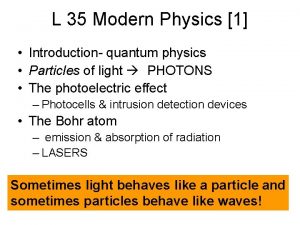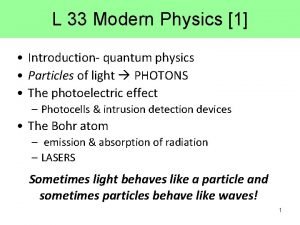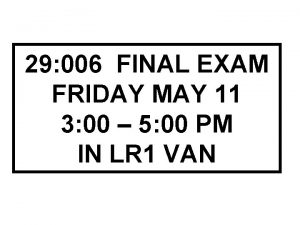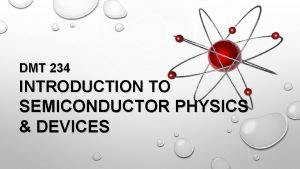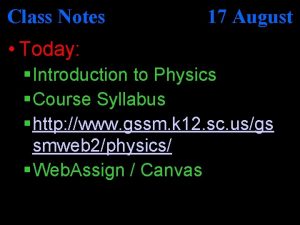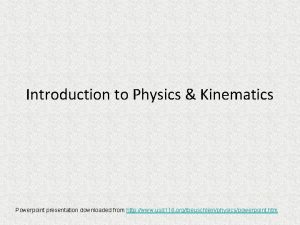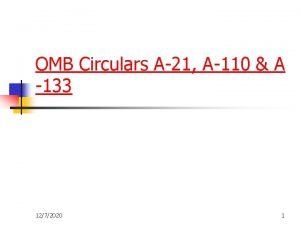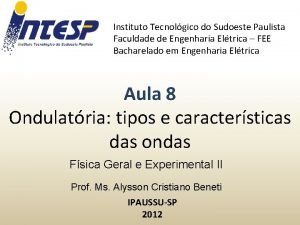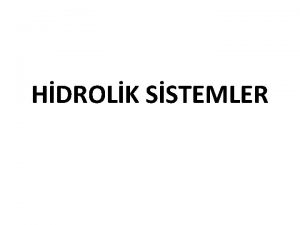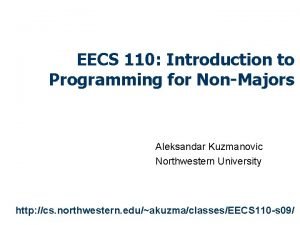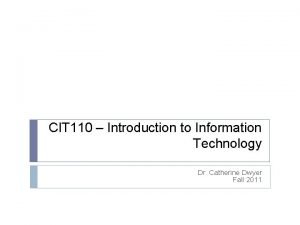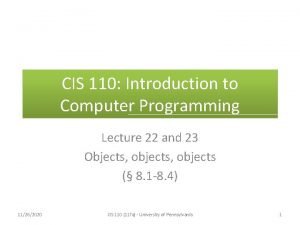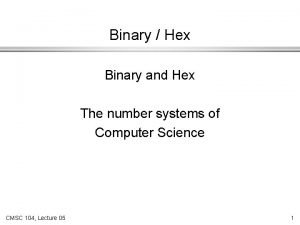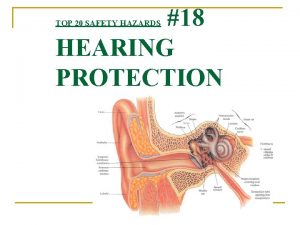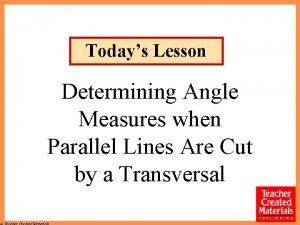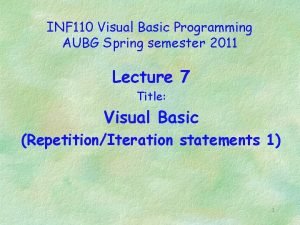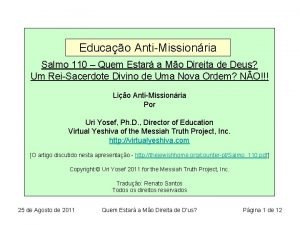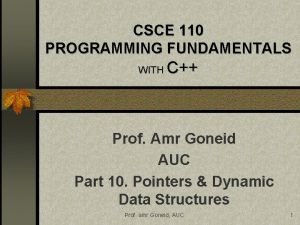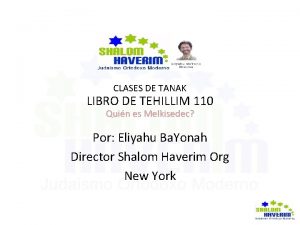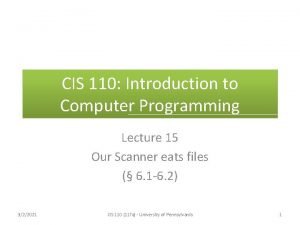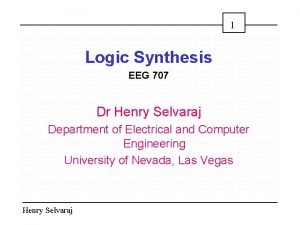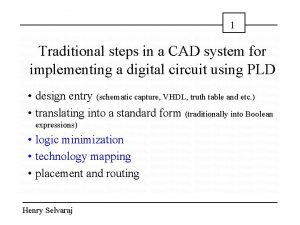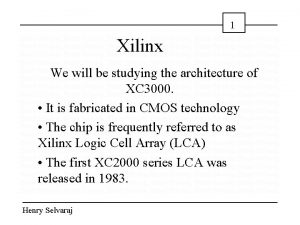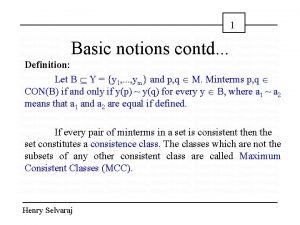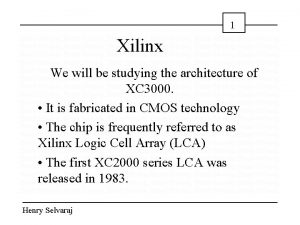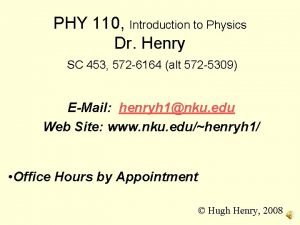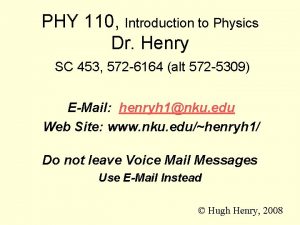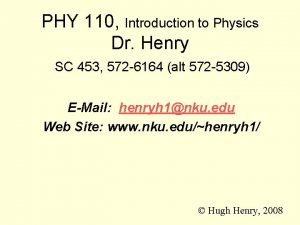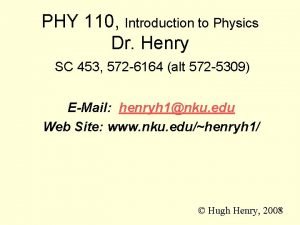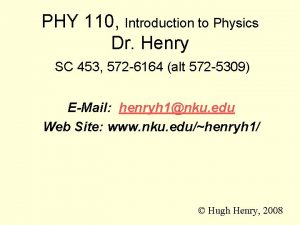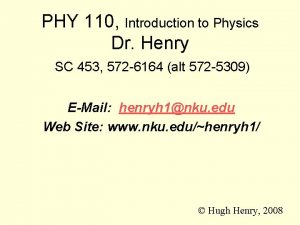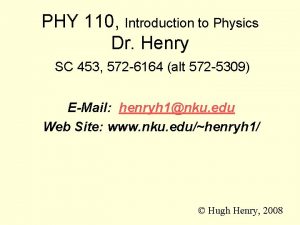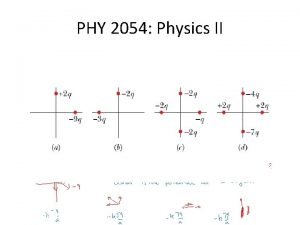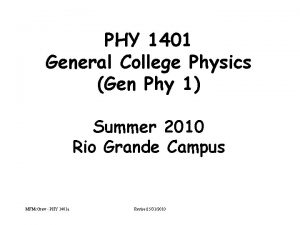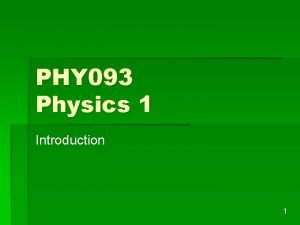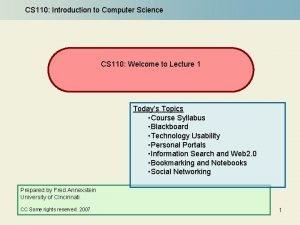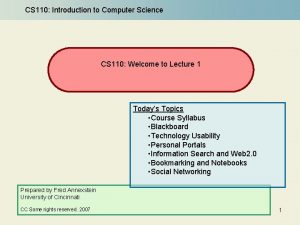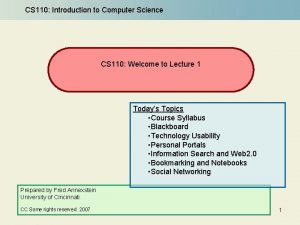PHY 110 Introduction to Physics Dr Henry SC















































































- Slides: 79

PHY 110, Introduction to Physics Dr. Henry SC 453, 572 -6164 (alt 572 -5309) E-Mail: henryh 1@nku. edu Web Site: www. nku. edu/~henryh 1/ © Hugh Henry, 2008

If you are Tardy Initial beside Your Name on the Sheet on the Front Table

Chapter 8 (Sections 8. 1 -8. 6) Electromagnetism and EM Waves © Hugh Henry, 2008

Magnetism n Magnets always have at least two poles. n A north pole and a south pole. n We have never observed a magnet with only one pole (a magnetic monopole). n As with electric charges, opposites attract: n North pole is attracted to south pole. n Like poles repel 4

Magnetism, cont’d n As with gravitation and electrostatics, it is useful to employ the concept of a magnetic field. n A magnetic field is produced by a magnet and acts as the agent of the magnetic force. n Here is an example of a magnetic field 5

Interactions between electricity and magnetism n Let’s summarize key aspects of electrostatics and magnetism we are already familiar with. Electric charges produce electric fields in the space around them. n An electric field causes a force on any charged object placed in it. n Magnets produce magnetic fields in the space around them. n A magnetic field causes a forces on the poles of any magnet placed in it. n 6

Interactions between electricity and magnetism, cont’d n When there is interplay between electricity and magnetism, the word electromagnetic or electromagnetism is used. n Numerous everyday items use electromagnetism: n electric motors, vacuum cleaners, computer disk drives, generators, microphones, microwave ovens, and many more. 7

Electricity and Electromagnetism Electricity 8

Electromagnetism was discovered by Michael Faraday in 1831: 9

Interactions between electricity and magnetism Faraday’s 1 st, remarkable discovery: n A changing magnetic field through a coil causes current to flow n n Change is essential: No change. . . no current Moving a magnet one direction makes current flow one way. Moving it the other direction reverses the current. 10

Interactions between electricity and magnetism, cont’d n This led to three observations which form the basis of electromagnetism: n Observation 1: A moving electric charge produces a magnetic field in the space around it. n An electric current produces a magnetic field around it. n A single charged particle creates a magnetic field only when it is moving. 11

Interactions between electricity and magnetism, cont’d n A DC current is a steady progression of electric charges. n The magnetic field: is constant, n has a strength proportional to the amount of current through the wire, and n has a strength that is inversely proportional to the distance from the wire. n 12

Interactions between electricity and magnetism, cont’d n In most applications a coil is uded instead of a straight wire. n The coil is a length of wire wrapped in the shape of a cylinder. n The field has the shape of a bar magnet. 13

Interactions between electricity and magnetism, cont’d n This type of device is called an electromagnet. It behaves like a permanent magnet, but only while the current is flowing. n If the current is stopped, the magnetic field vanishes. n 14

Interactions between electricity and magnetism, cont’d n A coil with a length much larger than its diameter is called a solenoid. n If an iron rod is partially inserted into a hollow core solenoid, the rod will be pulled into the solenoid when the current switches on. 15

Interactions between electricity and magnetism, cont’d n Useful examples of a solenoid include: n non-digital doorbell chimes, n electric door locks, and n starter motors on car and truck engines. 16

Interactions between electricity and magnetism, cont’d n The second observation of electromagnetism is the basis of electric generators: n Observation 2: A moving magnet produces an electric field in the space around it. n A coil of wire in motion relative to a magnet has a current induced in it. n This process is known as electromagnetic induction. 17

Interactions between electricity and magnetism, cont’d n The electric field produced by a moving magnet is circular (left). n Moving the magnet through a coil establishes a current in the coil. 18

Electric Generator Mechanical rotation of a coil in a magnet produces an electric current 19

Interactions between electricity and magnetism, cont’d n Here’s how a generator works: n As the coil rotates in the magnetic field, a current is established through the coil. n Rotating a coil through a fixed magnetic field produces a changing magnetic field in the coil 20

Interactions between electricity and magnetism, cont’d n In a hydroelectric power plant, the water turns a turbine which rotates the coils to generate electricity 21

Interactions between electricity and magnetism, cont’d n In a coal- or oil-fired or nuclear power plant, steam turns the turbine to generate electricity 22

Interactions between electricity and magnetism, cont’d n The third observation of electromagnetism is the basis of electric motors: n Observation 3: A magnetic field exerts a force on a moving electric charge. n A magnetic field exerts a force on a currentcarrying wire. 23

Interactions between electricity and magnetism, cont’d n This observation is in line with the first: n Anything that produces a magnetic field will itself be affected by other magnetic fields. n A moving charge or a current creates a magnetic field, which in turn experiences a force from other magnetic fields. 24

Interactions between electricity and magnetism, cont’d Note this interesting property: n The force experienced by a moving electric charge is perpendicular to the direction of the field and the current. 25

Interactions between electricity and magnetism, cont’d n Electric motors exploit this electromagnetic interaction. n An Electric Motor is the reverse of a Generator n A generator uses rotation to produce electricity; a motor uses electricity to produce rotation 26

Interactions between electricity and magnetism, cont’d n AC (alternating current) in wire causes it to spin in the magnetic field n This is because the direction of the current is reversed each time the loop is horizontal 27

Interactions between electricity and magnetism, cont’d n This strategic current reversal allows the magnetic force to continue rotating the coil. n The resultant spinning shaft does work (blowers, elevators, etc) 28

Interactions between electricity and magnetism, cont’d n A hair dryer is an example of an electric motor n The current drives the blower. 29

Principles of Electromagnetism n These three observations lead to two general statements about electromagnetism. n These are called the Principles of Electromagnetism: An electric current or a changing electric field induces a magnetic field. n A changing magnetic field induces an electric field. n 30

Principles of Electromagnetism, cont’d n We mentioned earlier about a transformer as a device to transform AC voltage and current. n Since an AC current is a time-varying current, it creates a changing magnetic field according to the principles of electromagnetism. 31

Principles of Electromagnetism, cont’d n A transformer consists of two coils in close proximity. n If an AC current is applied to the left coil, the changing current through the coil creates a changing magnetic field. n Hence the right coil experiences a changing magnetic field. 32

Principles of Electromagnetism, cont’d n Note that each loop of the coil has the same voltage induced in it. n When the coil has multiple loops, the voltage of the entire coil is the sum of the voltages of each loop. n Each loop is in series with the others, and voltages in series add. 33

Principles of Electromagnetism, cont’d n Because of energy conservation and the 2 nd Law of Thermodynamics, the power output (on the right) cannot be more than the power input (on the left). n Ideally they are equal. Hence 34

Principles of Electromagnetism, cont’d n The result is: n We can write this as: n Vi & Vo represent the input and output voltages. n Ni & No represent the number of coils on the input and output coils. 35

Principles of Electromagnetism, cont’d n Recall that a step-up transformer increases the output voltage. n So the output coil has more turns than the input coil. n A step-down transformer decreases the output voltage. n So the output coil has fewer turns than the input coil. 36

Example 8. 1 A transformer is being designed to have a 600 volt output with a 120 -volt input. If there are to be 800 turns of wire in the input coil, how many turns must there be in the output coil? 37

Example 8. 1 ANSWER: The problem gives us: The number of turns in the output coil is 38

Example 8. 1 ANSWER: Inserting the given values: 39

Other Applications of Electromagnetism n Television 40

Other Applications of Electromagnetism, cont’d n Cruise Control 41

Other Applications of Electromagnetism, cont’d n Magnetic Levitation 42

Electromagnetic Waves Electromagnetic_Waves 43

Electromagnetic waves n Electromagnetic waves are transverse waves consisting of a combination of oscillating electric and magnetic fields. 44

Electromagnetic waves, cont’d n EM waves travel at the “speed of light. ” n The symbol c represents the speed of light. n In this class we use c = 3 x 108 m/s 45

Electromagnetic waves n The general wave velocity formula v = fl holds for EM waves. n Since v=c for EM waves, the special formula for electromagnetic waves is: c = fλ 46

Example 8. 2 An FM radio station broadcasts an EM wave with a frequency of 100 megahertz. What is the wavelength of the wave? f = 100 MHz 47

Example 8. 2 ANSWER: The problem gives us: The wavelength is 48

Electromagnetic Spectrum What_is_Light_ 49

Applications of Electromagnetic Waves Putting_the_Electromagnetic_Spectrum_to_Use 50

Electromagnetic waves, cont’d n EM waves are categorized according to their wavelength and frequency. 51

Electromagnetic waves, cont’d Different Electromagnetic (EM) waves are used for different applications. As a rule of thumb: n For wave reflection, use a low frequency n The wavelength is longer than the size of objects n For wave transmission, use a high frequency n The wavelength is shorter than the size of objects n And also. . .

Electromagnetic waves, cont’d n High frequency (short wavelength) waves have the best resolution. n The wavelength is shorter than the size of object being “viewed. ” n Low frequency (long wavelength) waves maintain amplitude for longer distances. n With a longer wavelength, there are fewer oscillations per unit distance. These characteristics are used to select the right EM wave for various applications.

Electromagnetic waves, cont’d n Radiowaves, Microwaves, Infrared (IR) have lower frequency than visible light 54

Electromagnetic waves, cont’d n Radio waves are the lowest frequency EM waves. Their frequency range is from 100 to about 109 Hz. n They are sub-divided into several groups: n n ELF – extremely low frequency. VHF – very high frequency. UHF – ultra high frequency. 55

Electromagnetic waves, cont’d n AC current creates ELF waves. n ELF waves are used to communicate with underwater submarines

Electromagnetic waves, cont’d n Radio waves pass easily through the atmosphere so they are good for communications. n n Low frequency waves are reflected by the upper atmosphere. High frequency waves are used for space communications. 57

Electromagnetic waves, cont’d MRI: Magnetic Resonance Imaging (aka Nuclear Magnetic Resonance) n By applying a strong magnetic field and radio frequency (RF) radiation (f~108 Hz, λ~300 m) to the human body, a map of the internal tissue structure can be generated from the spinning motions of atomic nuclei. This is called magnetic resonance imaging (MRI). 58

Electromagnetic waves, cont’d The Physics is. . . n The nuclei of some atoms behave as if they were rotating, or spinning, much as a top spins about its central axis. n When placed in a strong magnetic field, the spinning motion of these atoms causes a rise in energy. 59

MRI Images 60

Electromagnetic waves, cont’d n Microwaves are the next highest frequency waves. They range from 109 to 1012 Hz. n They are used for communications and radar. n n Doppler radar uses microwaves and the Doppler effect to measure the speed of an object. 61

Electromagnetic waves, cont’d n Microwaves are able to penetrate clouds and smoke more effectively than lower frequency (longer wavelength) EM waves. n n This image shows the surface of Venus. Microwaves were used to penetrate thick cloud cover. 62

Electromagnetic waves, cont’d n Microwaves are also useful at heating certain substances, e. g. , water. n Water is a polar molecule. § The negative charge of the hydrogen is displaced from the positive charge of the oxygen. n When exposed to microwaves, the water molecules rotate because of the varying electric field. 63

Electromagnetic waves, cont’d n n n The increased motion of the molecules means increased kinetic energy. Recall that temperature is essentially the average kinetic energy of the molecules. The frequency 2, 450 MHz is used in most ovens. § This frequency is most effective at making the water molecules rotate. 64

Electromagnetic waves, cont’d Microwave Oven n Wavelength of the EM waves is in the order of 0. 1 m – so only a few wavelengths fill the oven “cavity” n Hence the turntable to heat evenly 65

Electromagnetic waves, cont’d Creation Hypothesis n In 1965, Penzias and Wilson discovered cosmic radiation with max power wavelength ~1. 06 mm (microwave region – equivalent to 2. 726 o. K blackbody radiation). n This was convincing evidence supporting the “Big Bang” theory of the creation of the universe, because this theory predicted cosmic radiation of this character. 66

Electromagnetic waves, cont’d n Infrared radiation is next higher in frequency. n It ranges from 1012 to about 4× 1014 Hz. n It is the predominant component in heat radiation. n IR is constantly emitted by molecules simply due to their thermal vibrations. n Remote controls use IR since it is cheap & effective at short range. 67

Electromagnetic waves, cont’d n Visible light extends beyond IR in frequency. n It ranges from 4× 1014 to 7. 5× 1014 Hz. 68

Electromagnetic waves, cont’d n There is nothing special about visible light. n n n It is simply another band of EM radiation. Our eyes are simply adapted to deciphering visible light as various colors. It is a surprisingly narrow band. n The highest frequency is barely double the lowest frequency. § The highest frequency we can hear is about 1, 000 times higher than the lowest audible frequency. n Like IR, it is emitted by hot objects. n Color can be a measure of an object’s temperature. 69

Electromagnetic waves, cont’d n Ultraviolet (UV), X- Rays, Gamma Rays have higher frequency than visible light 70

Electromagnetic waves, cont’d n Ultraviolet radiation begins at frequencies beyond those of the visible color violet. Its range is 7. 5× 1014 to 1018 Hz. n It is emitted by very hot objects as part of the heat radiation. n UV provides the energy for chemical reactions in the skin that cause tanning or “sunburns. ” n 71

Electromagnetic waves, cont’d n Fluorescent lights use the UV emitted by mercury atoms to cause a powder on the tube’s inner surface to emit visible light. n This powder is said to be fluorescent. n This is why CFL lights contain Mercury is highly toxic. . . Complex cleanup procedures for broken CFL’s can be viewed on the internet 72

Electromagnetic waves, cont’d n X-rays are the next higher frequency of EM waves. They extend from 1016 to 1020 Hz. n Their wavelengths are about 10 -8 to 10 -11 meters. n n n This corresponds to the size of atoms. They are useful for examining the atomic structure of materials. 73

Electromagnetic waves, cont’d n X-rays are used for medical imaging since materials containing relatively large atomic numbers reflect x-rays more than those with lower atomic number. n n The calcium in bones implies that bones reflect x-rays. The x-rays transmit more easily through the carbon and oxygen in skin and muscles. 74

Electromagnetic waves, cont’d n An x-ray image is really an image of the “shadow” cast by the object. n By contrast, a photograph is an image of the light reflected off the object. 75

Electromagnetic waves, cont’d X-rays are produced by bombarding a metal with high-energy electrons. n The electrons are rapidly decelerated as they strike the metal. n The decelerating electrons emit x-rays. n 76

Electromagnetic waves, cont’d n Gamma-rays are the highest frequency EM waves. Their frequency range is 3× 109 to beyond 1023 Hz. n Their wavelengths are on the scale of nuclear diameters. n They are used for Radiation Oncology. n More on this in Chapter 11 n 77

Important Equations, Chapter 8 c = 3*108 m/s 78

END
 Law of motion
Law of motion Introduction to physics 110
Introduction to physics 110 Vignette mutuelle 110/110
Vignette mutuelle 110/110 110 000 110 111 000 111
110 000 110 111 000 111 Phy 131 past papers
Phy 131 past papers Pa msu
Pa msu Great orthogonality theorem
Great orthogonality theorem Rotational statics
Rotational statics Phy theorem
Phy theorem Phy 113 past questions and answers
Phy 113 past questions and answers Phy 131 asu
Phy 131 asu Ddr phy architecture
Ddr phy architecture Phy 205
Phy 205 Eye phy
Eye phy Phy 2049
Phy 2049 Phy
Phy Phy
Phy Phy
Phy Atm packet phy
Atm packet phy Phy
Phy Phy 2049
Phy 2049 Real image
Real image Phy 1214
Phy 1214 Phy
Phy Complete motion diagram
Complete motion diagram Felix connects a wire coil to an ammeter
Felix connects a wire coil to an ammeter Life phy
Life phy Rikard blunck
Rikard blunck Phy 1214
Phy 1214 2012 phy
2012 phy Phy-105 5 discussion
Phy-105 5 discussion Stephen hill fsu
Stephen hill fsu Phy 212
Phy 212 General physics chapters
General physics chapters Vx=vox+axt
Vx=vox+axt Nearsightedness physics
Nearsightedness physics Phy 132
Phy 132 Phy 1214
Phy 1214 Phy 108
Phy 108 Phy tgen
Phy tgen Why does it happen
Why does it happen University physics with modern physics fifteenth edition
University physics with modern physics fifteenth edition Physics ia ideas
Physics ia ideas Introduction to static equilibrium mastering physics
Introduction to static equilibrium mastering physics Modern physics introduction
Modern physics introduction Modern physics introduction
Modern physics introduction Modern physics introduction
Modern physics introduction Device physics
Device physics Webassign
Webassign Physics chapter 1 introduction and mathematical concepts
Physics chapter 1 introduction and mathematical concepts Atmospheric chemistry lecture notes
Atmospheric chemistry lecture notes Kinematics ppt
Kinematics ppt Troop 110
Troop 110 Sebuah plat baja berbentuk persegi dengan sisi 30 cm
Sebuah plat baja berbentuk persegi dengan sisi 30 cm Omb circular a-110
Omb circular a-110 Nst 110
Nst 110 000 miller indices
000 miller indices Derive planar density expressions for bcc (100) and (110)
Derive planar density expressions for bcc (100) and (110) Uma onda possui uma frequencia angular de 110 rad/s
Uma onda possui uma frequencia angular de 110 rad/s Hızınız 110 yavaş aq
Hızınız 110 yavaş aq Comp sci 110 northwestern
Comp sci 110 northwestern Cit 110
Cit 110 Cis 110 upenn
Cis 110 upenn 110 binary to decimal
110 binary to decimal Kısmi basınç formül
Kısmi basınç formül Fahrenheit 451 pages 93-110 summary
Fahrenheit 451 pages 93-110 summary 110 decibels
110 decibels Psalm 110 1
Psalm 110 1 Transversal of parallel lines find angle measures
Transversal of parallel lines find angle measures If r s t u v 110
If r s t u v 110 Sacar preterite endings
Sacar preterite endings Olodanterol
Olodanterol It 110
It 110 Inf 110
Inf 110 Salmo 110 1
Salmo 110 1 Csce 110 tamu syllabus
Csce 110 tamu syllabus Tehilim 110
Tehilim 110 Cis 110 syllabus
Cis 110 syllabus Csct-110
Csct-110 Iec tc110
Iec tc110
